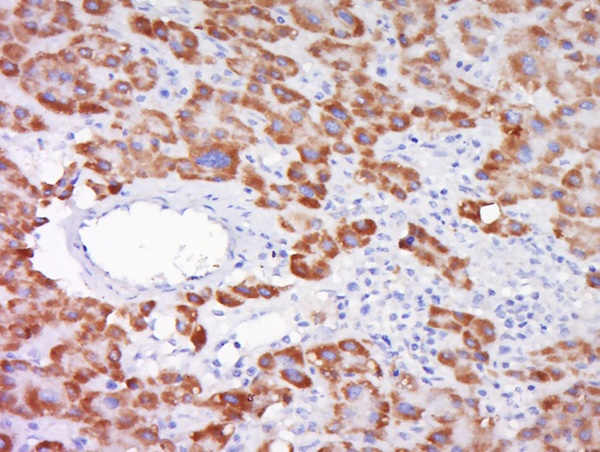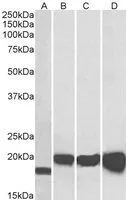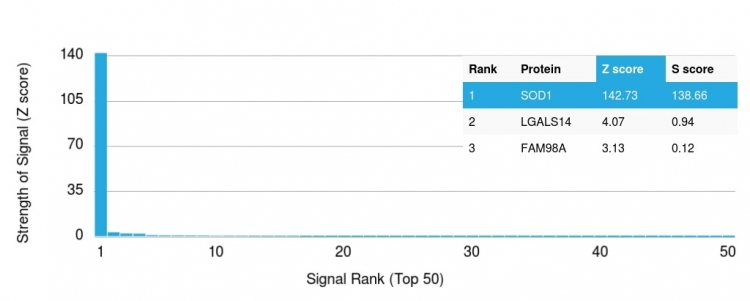SOD1 antibody
GTX100554
ApplicationsImmunoFluorescence, Western Blot, ELISA, ImmunoCytoChemistry, ImmunoHistoChemistry, ImmunoHistoChemistry Paraffin
Product group Antibodies
TargetSOD1
Overview
- SupplierGeneTex
- Product NameSOD1 antibody
- Delivery Days Customer9
- Application Supplier NoteWB: 1:500-1:10000. ICC/IF: 1:100-1:1000. IHC-P: 1:100-1:1000. ELISA: 1:1000-1:10000. *Optimal dilutions/concentrations should be determined by the researcher.Not tested in other applications.
- ApplicationsImmunoFluorescence, Western Blot, ELISA, ImmunoCytoChemistry, ImmunoHistoChemistry, ImmunoHistoChemistry Paraffin
- CertificationResearch Use Only
- ClonalityPolyclonal
- Concentration0.15 mg/ml
- ConjugateUnconjugated
- Gene ID6647
- Target nameSOD1
- Target descriptionsuperoxide dismutase 1
- Target synonymsALS, ALS1, HEL-S-44, IPOA, SOD, STAHP, hSod1, homodimer, superoxide dismutase [Cu-Zn], Cu/Zn superoxide dismutase, SOD, soluble, epididymis secretory protein Li 44, indophenoloxidase A, superoxide dismutase 1, soluble, superoxide dismutase, cystolic
- HostRabbit
- IsotypeIgG
- Protein IDP00441
- Protein NameSuperoxide dismutase [Cu-Zn]
- Scientific DescriptionThe protein encoded by this gene binds copper and zinc ions and is one of two isozymes responsible for destroying free superoxide radicals in the body. The encoded isozyme is a soluble cytoplasmic protein, acting as a homodimer to convert naturally-occuring but harmful superoxide radicals to molecular oxygen and hydrogen peroxide. The other isozyme is a mitochondrial protein. Mutations in this gene have been implicated as causes of familial amyotrophic lateral sclerosis. Rare transcript variants have been reported for this gene. [provided by RefSeq]
- Storage Instruction-20°C or -80°C,2°C to 8°C
- UNSPSC12352203
References
- Ayoubi R, Alshafie W, You Z, et al. Identification of high-performing antibodies for Superoxide dismutase [Cu-Zn] 1 (SOD1) for use in Western blot, immunoprecipitation, and immunofluorescence. F1000Res. 2023,12:391. doi: 10.12688/f1000research.132952.2Read this paper
- Kogami M, Abe S, Nakamura H, et al. Fenofibrate attenuates the cytotoxic effect of cisplatin on lung cancer cells by enhancing the antioxidant defense system in vitro. Oncol Lett. 2023,26(1):313. doi: 10.3892/ol.2023.13899Read this paper
- Brinks R, Wruck CJ, Schmitz J, et al. Nrf2 Activation Does Not Protect from Aldosterone-Induced Kidney Damage in Mice. Antioxidants (Basel). 2023,12(3). doi: 10.3390/antiox12030777Read this paper
- Mesquita PHC, Osburn SC, Godwin JS, et al. Effects of aging and long-term physical activity on mitochondrial physiology and redox state of the cortex and cerebellum of female rats. Physiol Rep. 2022,10(24):e15542. doi: 10.14814/phy2.15542Read this paper
- Baek Y, Woo TG, Ahn J, et al. Structural analysis of the overoxidized Cu/Zn-superoxide dismutase in ROS-induced ALS filament formation. Commun Biol. 2022,5(1):1085. doi: 10.1038/s42003-022-04017-0Read this paper
- Ramos H, Bogdanov P, Huerta J, et al. Antioxidant Effects of DPP-4 Inhibitors in Early Stages of Experimental Diabetic Retinopathy. Antioxidants (Basel). 2022,11(7). doi: 10.3390/antiox11071418Read this paper
- Wu YL, Chang JC, Chao YC, et al. In Vitro Efficacy and Molecular Mechanism of Curcumin Analog in Pathological Regulation of Spinocerebellar Ataxia Type 3. Antioxidants (Basel). 2022,11(7). doi: 10.3390/antiox11071389Read this paper
- Sulistyowati E, Hsu JH, Lee SJ, et al. Potential Actions of Baicalein for Preventing Vascular Calcification of Smooth Muscle Cells In Vitro and In Vivo. Int J Mol Sci. 2022,23(10). doi: 10.3390/ijms23105673Read this paper
- Dogan AE, Hamid SM, Yildirim AD, et al. PACT establishes a posttranscriptional brake on mitochondrial biogenesis by promoting the maturation of miR-181c. J Biol Chem. 2022,298(7):102050. doi: 10.1016/j.jbc.2022.102050Read this paper
- Lai TC, Chen YC, Cheng HH, et al. Combined exposure to fine particulate matter and high glucose aggravates endothelial damage by increasing inflammation and mitophagy: the involvement of vitamin D. Part Fibre Toxicol. 2022,19(1):25. doi: 10.1186/s12989-022-00462-1Read this paper





![FACS analysis of A431 cells using GTX83012 SOD1 antibody [6F5]. Green : SOD1 Purple : negative control](https://www.genetex.com/upload/website/prouct_img/normal/GTX83012/GTX83012_20170912_FACS_w_23061322_639.webp)
![IHC-P analysis of human breast adenocarcinoma tissue using GTX83592 SOD1 antibody [8B10]. Antigen retrieval : Heat-induced epitope retrieval by 10mM citrate buffer, pH6.0, 100oC for 10min.](https://www.genetex.com/upload/website/prouct_img/normal/GTX83592/GTX83592_1620_IHC-P_w_23061420_174.webp)

